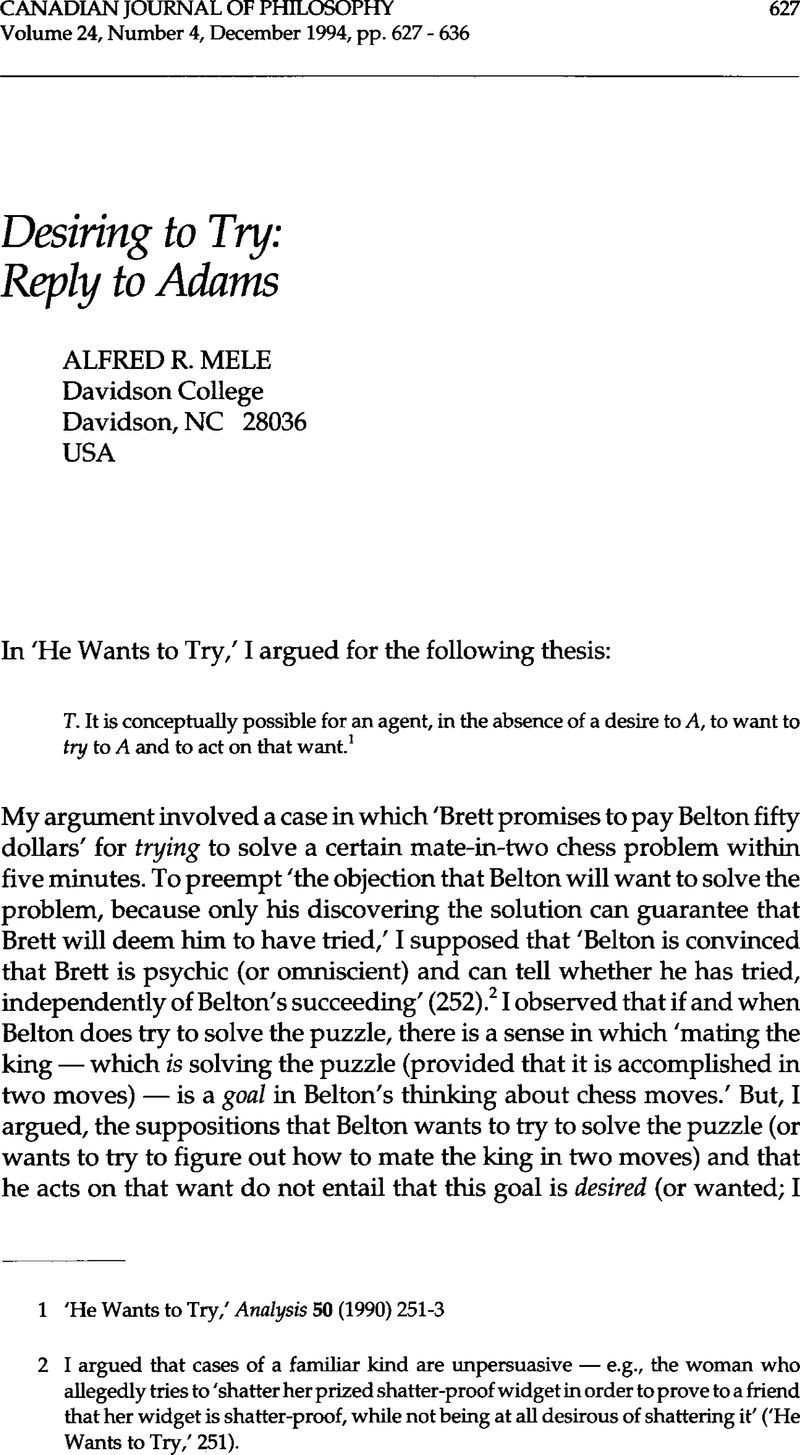Article contents
Desiring to Try: Reply to Adams
Published online by Cambridge University Press: 01 January 2020
Abstract

- Type
- Reply
- Information
- Copyright
- Copyright © The Authors 1987
References
1 ‘He Wants to Try,’ Analysis 50 (1990) 251-3
2 I argued that cases of a familiar kind are unpersuasive—e.g., the woman who allegedly tries to ‘shatter her prized shatter-proof widget in order to prove to a friend that her widget is shatter-proof, while not being at all desirous of shattering it’ (’He Wants to Try,’ 251).
3 My ‘subsequent paper’ is ‘He Wants to Try Again: A Rejoinder,’ Analysis 51 (1991) 225-8; Adams’s rebuttal is ‘He Doesn’t Really Want to Try,’ Analysis 51 109-12; his new attempt is ‘Trying, Desire, and Desiring to Try,’ in this volume.
4 See my Springs of Action (New York: Oxford University Press 1992).
5 Fred Dretske has argued that a componential view of the sort at issue is instrumental in solving the problem of the causal relevance of mental states in Explaining Behavior (Cambridge, MA: MIT Press 1988) and in establishing the possibility of free action in ‘The Metaphysics of Freedom,’ Canadian Journal of Philosophy 22 (1992) 1-13. For a reply to the first claim, see my ‘Dretske’s Intricate Behavior,’ Philosophical Papers20 (1991) 1-10. For criticism of the second, see Davison, S. ‘Dretske on the Metaphysics of Freedom,’ Analysis 54 (1994) 115-23CrossRefGoogle Scholar, and McCann, H. ‘Dretske on the Metaphysics of Freedom,’ Canadian Journal of Philosophy 23 (1993) 619-30CrossRefGoogle Scholar.
6 See Searle, J. Intentionality (Cambridge: Cambridge University Press 1983)CrossRefGoogle Scholar. In my ‘Are Intentions Self-Referential?’ Philosophical Studies 52 (1987) 309-29 and elsewhere I argue that the view that all intentions are self-referring (i.e., that the content of any intention refers to that very intention) has psychologically unrealistic implications for toddler’s intentions. I have not quarreled with the idea that some intentions or desires are self-referring, and I have no reservations about there being second-order desires.
7 I myself have never claimed that infants and animals desire to try to do things, even though I have claimed that they desire to do things and that they try to do things.
8 For references to some relevant empirical work, see my Springs of Action, 225, n.12. Also see Gopnik, A. ‘How we Know our Minds: The illusion of First-Person Knowledge,’ Behavioral and Brain Sciences 16 (1993) 1-14CrossRefGoogle Scholar.
9 Here I ignore various complications and maneuvers addressed in Springs of Action, 204-6.
10 This dispute is skirted in ‘The Intention/Volition Debate.’
11 Adams will claim that being settled upon doing one’s best to A is sufficient for intending to A; and I reject the claim. On my view, intending to A is incompatible with believing that one probably will not A (Springs of Action, ch. 8); and Belton believes that his attempt to solve the problem probably will not generate a solution (’He Wants to Try’). Further, an intention to A, on my view, encompasses motivation to A (Springs of Action); and Belton is motivationally indifferent to his solving the puzzle. (Incidentally, S’s wanting to A plainly is compatible with S’s believing that he probably will not A.)
12 I am grateful to Fred Adams for discussion and to Bob Ware for advice about condensing a draft.
- 1
- Cited by




